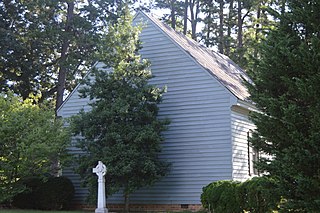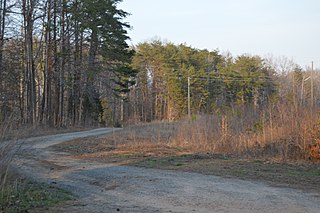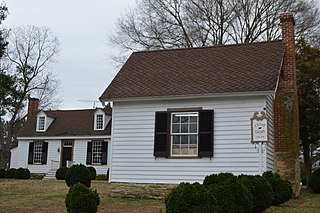Related Research Articles
Halifax is a town in Halifax County, Virginia, United States, along the Banister River. The population was 1,309 at the 2010 census. It is the county seat of Halifax County.

Buildings, sites, districts, and objects in Virginia listed on the National Register of Historic Places:
Arlington is an unincorporated community along the Little Kanawha River in Upshur County, West Virginia, United States. Alfious Arlington Fidler, an early postmaster, gave the town his middle name. Its nineteenth century Fidler's Mill is listed on the National Register of Historic Places. Arlington is located south of Rock Cave.

Berry Hill Plantation, also known simply as Berry Hill, is a historic plantation located on the west side of South Boston in Halifax County, Virginia, United States. The main house, transformed c. 1839 into one of Virginia's finest examples of Greek Revival architecture, was designated a National Historic Landmark in 1969. The surviving portion of the plantation, which was once one of the largest in the state, is now a conference and event center.

Staunton River Battlefield State Park is a state park located in Virginia. The park straddles the Staunton River in Halifax and Charlotte counties. The Roanoke visitor center in Randolph, Virginia is a railroad depot which now holds exhibits on Native Americans and railroad history. The Clover visitor center has exhibits on the American Civil War and the battle which took place on this site. It also includes information about the production of electric energy. The park also includes the Mulberry Hill plantation, given to the state in 1999.

This is a list of the National Register of Historic Places listings in Halifax County, Virginia.
Indian Cave Petroglyphs may refer to:
Indian Cave Petroglyphs is a historic archaeological site located near Good Hope, Harrison County, West Virginia. It consists of petroglyphs occupying an area of 20 feet by 4 feet on the back wall of a rockshelter. These artifacts were first reported by archaeologist William Henry Holmes (1846-1933) of the Bureau of American Ethnology who visited the area in 1889. He also found pottery that indicates an occupation or occupations between 500 and 1675.
Alton is an unincorporated community in Halifax County, Virginia, United States.
Vernon Hill is an unincorporated community in Halifax County, Virginia, United States. Vernon Hill is located on Virginia State Route 360 9.7 miles (15.6 km) west of Halifax. Vernon Hill has a post office with ZIP code 24597, which opened on September 8, 1856.

Halifax Historic District is a national historic district located at Halifax, Halifax County, North Carolina, US that was listed on the National Register of Historic Places in 1970. It includes several buildings that are individually listed on the National Register. Halifax was the site of the signing of the Halifax Resolves on April 12, 1776, a set of resolutions of the North Carolina Provincial Congress which led to the United States Declaration of Independence gaining the support of North Carolina's delegates to the Second Continental Congress in that year.

Halifax County Courthouse is a historic county courthouse located at Halifax, Halifax County, Virginia. It was designed and built in 1838-1839 by Dabney Cosby. It is a two-story, T-shaped brick building in the Federal style. The front facade features a two-story, tetrastyle portico in the Greek Ionic order.

Old Providence Presbyterian Church, also known as Halifax Presbyterian Church, is a historic Presbyterian church located at Providence, Halifax County, Virginia. It was built about 1830, and is a rectangular, one-story, single room, gable roofed frame structure. It measures approximately 26 feet by 31 feet.

South Boston Historic District is a national historic district located at South Boston, Halifax County, Virginia. The district includes 594 contributing buildings and 7 contributing structures in the Village of South Boston. It consists of industrial, commercial, and residential building types dating from the mid-19th century to the present. Notable buildings include the C.H. Friend School, New Brick Warehouse, Planters and Merchants Bank, Halifax Cotton Mill, R.J. Reynolds Tobacco Company tobacco prizery, former Liggett-Meyer Tobacco Company tobacco prizery, the Parkinson Block (1899), First Presbyterian Church (1887), First Baptist Church, and Mt. Olive Baptist Church.

Town of Halifax Court House Historic District is a national historic district located at Halifax, Halifax County, Virginia. The district includes 172 contributing buildings, 1 contributing site, 13 contributing structures, and 1 contributing object in the Town of Halifax. Resources include government, commercial, residential, religious, educational and industrial buildings that date from the early-19th Century to the mid-20th century. Notable buildings include the Rice House, Edmunds/Lewis Office (1869), People's Bank, Beth Car Baptist Church (1892), Christ Episcopal Church, Saint Luke's Christian Methodist Episcopal Church, Dr. Carter House, County Office Building (1915), Town of Halifax Swimming Pool (1930s), Municipal Building/ Fire Station (1950), Halifax Roller Mills (1915), Halifax Planing Mill, Halifax Department Store (1949), and Randolph Theater. Also located in the district is the separately listed Halifax County Courthouse.
Daugherty's Cave and Breeding Site is a Native American archaeological site in Russell County, Virginia, near Lebanon. The site includes materials dating from the Early Archaic Period to the time of European contact. Digs at the site have recovered large numbers of animal bones dating from the Middle Archaic Period.

The Collins Ferry Historic District encompasses two historic farmsteads, as well as a mill and ferry site on the Staunton River in rural northern Halifax County, Virginia, west of Brookneal. The district covers 768 acres (311 ha), extending south from the river roughly to Bull Creek Road, and westward from the mouth of Buffalo Creek, which roughly bisects the district. The Collins Farm, which is located at the end of McKeever's Trail, includes one of Halifax County's best-preserved Federal style plantation houses, built c. 1810 and located on a bluff overlooking the creek. The Collins Farm includes 19th century farm outbuildings, the family cemetery, a mill site along the river, and the site where stones for the mill's construction and grinding stones were quarried. The Hubbard Farm is located south and east of the Collins Farm, and is accessed via a private drive that forms part of the historic road leading to Collins Ferry. Hubbard Farm includes a Greek Revival farmhouse built in 1856, and also includes 19th century outbuildings, a family cemetery, and the remains of a slave quarters.

Bloomsburg, also known as the Watkins House, is a historic plantation estate located at 9000 Philpott Road southwest of South Boston, Halifax County, Virginia. The main house was completed about 1839, after seven years of construction, by Alexander Watkins, a local farmer and businessman. It is a two-story brick structure, with a Greek temple portico that appears to be a 20th-century addition, but is by lore similar to an original one. The house is one of Halifax County's early Greek Revival plantation houses.

Cedar Grove is a historic farm property at 1083 Blanes Mill Road in rural southern Halifax County, Virginia, north of Alton. The farm's main house is a two-story frame structure, estimated to have been built about 1775 but also altered several times in the 19th century. Its interior has a combination of Federal and Greek Revival features, and the domestic outbuildings of the property include an office with Greek and Gothic Revival features, and a small family cemetery. The house is believed to be one of the oldest surviving buildings in the county.

Glenwood is a historic plantation estate located at 7040 Philpott Road southwest of South Boston, Halifax County, Virginia. The main house was completed about 1861, and is a distinctive combination of mid-19th century architectural styles. The main house is a two-story wood-frame structure, with a hip roof. The cornice has Italianate brackets, and the main entrance is framed by sidelights and a transom window with Gothic tracery. The interior features an fine Gothic staircase. Attached to the rear of the house by a hyphen is an earlier 19th-century log house.
References
- 1 2 "National Register Information System". National Register of Historic Places . National Park Service. July 9, 2010.
- ↑ "Virginia Landmarks Register". Virginia Department of Historic Resources. Retrieved June 10, 2024.
- ↑ Dan Shaw (2012). "Battlefield - Clover - Providence Driving Tour Halifax County, Virginia: Indian Jim's Cave". Halifax Web WorX.

